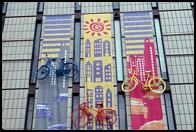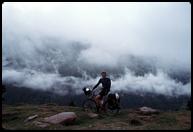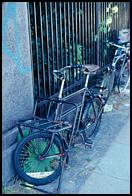
|
Equipment
|
This page describes in some detail the equipment I used on my trip and
the problems that I had with it. I feel that it is close to the
minimal packing list if you
- travel for several weeks;
- camp at least some of the time;
- spend significant time in remote areas with few stores or other
facilities;
- expect to encounter severe weather;
- care about your photos.
If you are cycling for just two or three weeks, plan to stay in
hotels, and don't expect particularly bad weather, you may be better
served by Jobst Brandt's minimal
bicyle tour checklist. Minimal is beautiful.
Bike
 I used my every-day commuting and utility bike, a red 1991 Bridgestone MB-4
mountain bike fitted with semi-slick tires and drop bars like those of a
road bike. Mixed drivetrain: Suntour XC Pro front derailleur and XCE
cranks, Shimano STX rear derailleur, LX bottom bracket, 12-25 8-speed
Dura-Ace cassette, Sachs chain. Shimano 747 SPD pedals. Home-built wheels:
Shimano LX hub, DT swaged spokes, and Sun double-walled rim on the front,
Shimano XT hub, DT straight-gauge spokes, and Mavic double-walled rim on the
rear. 8-year-old Ritchey headset. Salsa stem. ITM drop bars with cork
tape. Dia-Compe brakes and brake levers. Stylish late-70s Raleigh bar-end
shifters. Vetta racing saddle. Front and rear lights powered by a Union
rear-wheel generator; also a flashing rear light powered by AA batteries.
Vetta C15 computer. Mt Zefal fenders front and rear. Sturdy Blackburn
rack.
I used my every-day commuting and utility bike, a red 1991 Bridgestone MB-4
mountain bike fitted with semi-slick tires and drop bars like those of a
road bike. Mixed drivetrain: Suntour XC Pro front derailleur and XCE
cranks, Shimano STX rear derailleur, LX bottom bracket, 12-25 8-speed
Dura-Ace cassette, Sachs chain. Shimano 747 SPD pedals. Home-built wheels:
Shimano LX hub, DT swaged spokes, and Sun double-walled rim on the front,
Shimano XT hub, DT straight-gauge spokes, and Mavic double-walled rim on the
rear. 8-year-old Ritchey headset. Salsa stem. ITM drop bars with cork
tape. Dia-Compe brakes and brake levers. Stylish late-70s Raleigh bar-end
shifters. Vetta racing saddle. Front and rear lights powered by a Union
rear-wheel generator; also a flashing rear light powered by AA batteries.
Vetta C15 computer. Mt Zefal fenders front and rear. Sturdy Blackburn
rack.
Bags
Jandd Mountaineering, indestructible after 5 years of touring and
day-to-day use. Two big rear panniers hold most of the gear; the tops
unzip and expand to fit extra stuff. The panniers are relatively
water-resistant, but I lined the inside with heavy duty garbage bags,
and sealed all items separately inside ziploc freezer bags. In Norway, everything got wet anyway. A large
handlebar bag carries most of my camera gear and important documents;
a quick-release mount and shoulder strap allow it to become a
comfortable shoulder bag in seconds. Extra garbage bags, ziploc bags,
and nylon straps or bungee cords always come in handy.
Gear
- Lightweight 2-man tent and groundsheet.
- Small foam sleeping mat (just enough to cover shoulders and back).
- Synthetic-fill mummy bag rated to 40 deg F: very light, and generally all
you need when cycling in summer. In Norway, though, I was sleeping
fully-clothed and with a wool hat on my head.
- Camera gear: Nikon N70 SLR, 24mm/f2.8, 50mm/f1.8, and 85mm/f1.8 lenses.
Camera and lenses travel in home-made protective pouches made of electrical
tape, bubble wrap, and foam. Small lightweight (1.5lbs) tripod with QR
mount. Polarizing filter. Spare batteries. Cleaning kit. Roughly 60
rolls of Kodak and Fuji slide film, mostly Kodachrome 64 and Fuji Sensia
100. I use prepaid mailers because they're cheaper: $5-8 for a 36-exposure
roll and development, depending on the type of film. Every couple of weeks
I stop at a post office and send a package with recently exposed rolls and
corresponding mailers to Kodak or Fuji labs, together with instructions to
send the results home to Boston.
- Maps: mostly scale 1:400,000 or 1:300,000. That's pretty low detail
(recommended maps for cycling are 1:100,000 or 1:200,000), yet I was still
carrying over a couple pounds of maps. I'm not a big fan of buy-as-you-go:
for me, dreaming in front of a map at home months prior to departure is a
big part of any trip.
- Tools: patch kit, tire levers, pump, an assortment of wrenches and Allen
keys, flat and Philips screwdrivers, cone wrenches (1 tool has 14mm, 15mm,
32mm, and 36mm, plus a bottle opener for when the job is done), spoke
wrench, cassette breaker, chain tool, crank bolt wrench, Shimano cartridge
bottom bracket tool, electric tape, chain lube, some grease (as much
as will fit in one of the small plastic canisters that rolls of 35mm
film come in), small flashlight.
- Spare parts: inner tube, tire, spokes, brake pads, rack bolts, seat bolt,
crank bolt, light bulbs.
- Clothing: 2 bicycle outfits (wool jersey, lycra shorts, wool
socks), cycling goves, polypro liner gloves, waterproof outer shell
gloves, wool hat, excellent Burley rain jacket, long thermal tights,
waterproof pants, Burley waterproof booties, Shimano SPD-compatible
cycling shoes (good both for cycling and walking), plastic sandals for
walking fearlessly into sketchy showers, 2 pairs of underwear, 1 pair
of shorts, 1 short-sleeved T-shirt, 1 long-sleeved T-shirt, 1
synthetic wrinkle-free quick-dry outfit (short-sleeved shirt and long
pants), 1 fleece, 1 extra pair of wool socks, 2 pairs of polypro
socks.
- Hygiene (heh!): toothbrush, toothpaste, floss, comb, nail clipper, razor,
shaving cream, liquid soap, quick-dry camping towel, roll of toilet paper.
- Medical: ibuprofen, bronchial dilator in case of allergy-induced asthma
attacks, disinfectant, gauze and band-aids in case of minor cuts and
scrapes. Also some fungus killer for use after very sketchy showers (see
plastic sandals above).
- Documents: passport, tickets, cash, ATM card, notebook, pens.
- Food for the day (or days, in the vast wastes of northern Norway) sits in
a big sack that is strapped across the top of the rear panniers together
with the sleeping mat, tripod, and spare tire.
Replaced parts

- Front and rear tires, both "Continental Avenue" 26x1.3 semi-slicks, new at
start, replaced in Bergen (Norway), after just 1500km! The rear one was
worn to the cords, and the front one had a ruptured sidewall. Replaced with
"Schwalbe City Jet" 26x1.5 semi-slicks. The replacement rear tire was worn
smooth but still ok by the end of the trip (I'm still using it). The front
tire is fine. Norwegian roads were bad but not that bad: maybe I just got a
bum pair of Contis.
- Rear rim (Mavic 517) cracked around a drive-side spoke in Norway after
just over 1500km. Not sure why: wheel was true and tension on all spokes
seemed normal. Replaced with a similar German rim in Thisted, Denmark. The
new wheel creaked and groaned terribly in the Alps, but a thorough loosening
and retensioning fixed things again; it's still true after 6000km.
- Rear brake pads (Ritchey red type), almost new at start, had to be
replaced in Viborg, Denmark, after about 2000km. Replaced with Kool-Stop
red type, still going strong 5000km later.
- Front break pads (Ritchey red type), new at start, replaced in Oetz
(Austria), after a scary descent in the rain from Kuehtai.
Replaced with anonymous but excellent brand purchased in Denmark.
- Chain and rear cassette (Shimano Dura-Ace 12-25), new at start, replaced
in Abano Terme (Italy), after about 5000km. Cassette is a cheap Shimano
clone: original 8-speed Dura-Ace costs approx.$180 in Italy (U.S. price is
approx.$50)!
- "Bridge cable" that joins the rear brake cantilevers, not new at start,
became frayed and had to be replaced in Abano Terme. You don't want frayed
brake cables in the Alps.
Problems
Norway aside, my trip was incredibly trouble-free.
- I had to slightly true my rear wheel (all the load except for the
camera equipment and a few sundries was on the rear) four times, and
the front wheel once.
- The headset required tightening a couple of times, as did the
cranks.
- I oiled my chain a few times after heavy rain.
- The quick release mount for the handlebar bag cracked on the very
first Polish pothole, just a few meters after I rolled off the ferry,
but an extra nylon strap fixed the problem perfectly.
- I suffered two flats due to complete tire failure in Norway.
After that, I only had 5 flats: one in Denmark, two in Austria, and
two in Italy. If you ignore Norway, that's just a bit more than one
flat every thousand miles: not bad, considering the load.
Shameless
unpaid commercial: Fix your bike at Broadway Bikes, 351 Broadway,
Cambridge, MA, and you too will enjoy miles of trouble-free cycling!
(As long as you avoid Norway, of course.)


 I used my every-day commuting and utility bike, a red 1991 Bridgestone MB-4
mountain bike fitted with semi-slick tires and drop bars like those of a
road bike. Mixed drivetrain: Suntour XC Pro front derailleur and XCE
cranks, Shimano STX rear derailleur, LX bottom bracket, 12-25 8-speed
Dura-Ace cassette, Sachs chain. Shimano 747 SPD pedals. Home-built wheels:
Shimano LX hub, DT swaged spokes, and Sun double-walled rim on the front,
Shimano XT hub, DT straight-gauge spokes, and Mavic double-walled rim on the
rear. 8-year-old Ritchey headset. Salsa stem. ITM drop bars with cork
tape. Dia-Compe brakes and brake levers. Stylish late-70s Raleigh bar-end
shifters. Vetta racing saddle. Front and rear lights powered by a Union
rear-wheel generator; also a flashing rear light powered by AA batteries.
Vetta C15 computer. Mt Zefal fenders front and rear. Sturdy Blackburn
rack.
I used my every-day commuting and utility bike, a red 1991 Bridgestone MB-4
mountain bike fitted with semi-slick tires and drop bars like those of a
road bike. Mixed drivetrain: Suntour XC Pro front derailleur and XCE
cranks, Shimano STX rear derailleur, LX bottom bracket, 12-25 8-speed
Dura-Ace cassette, Sachs chain. Shimano 747 SPD pedals. Home-built wheels:
Shimano LX hub, DT swaged spokes, and Sun double-walled rim on the front,
Shimano XT hub, DT straight-gauge spokes, and Mavic double-walled rim on the
rear. 8-year-old Ritchey headset. Salsa stem. ITM drop bars with cork
tape. Dia-Compe brakes and brake levers. Stylish late-70s Raleigh bar-end
shifters. Vetta racing saddle. Front and rear lights powered by a Union
rear-wheel generator; also a flashing rear light powered by AA batteries.
Vetta C15 computer. Mt Zefal fenders front and rear. Sturdy Blackburn
rack.
